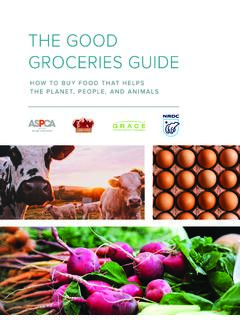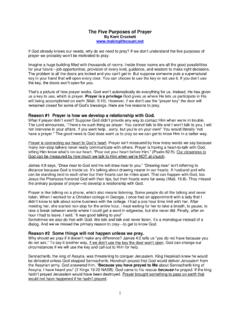Transcription of A GrowinG Problem Selective breedinG in the chicken ...
1 A GrowinG ProblemSelective breedinG in the chicken induStry: the cASe for Slower GrowthtAble of contentS ExEcutivE SummarySElEctivE breedinG for faSt and ExcESSivE growth welfare costs Labored Movement Chronic Hunger for breedinG Birds Compromised Physiological FunctionintEraction BEtwEEn growth and living conditionS human health concerns Antibiotic Resistance Diseasesmoving to SlowEr growthrEfErEncESCover photo: Christine 16A GrowinG ProblemSelective breedinG in the chicken induStry: the cASe for Slower Growthpage 2eXecutive SummAryin an age when the horrors of factory farming are becoming more well-known and people are increasingly interested in where their food comes from, few might be surprised that factory farmed chickens raised for their meat sometimes called broiler chickens live miserable lives in horrendous conditions.
2 But less well-known is the fact that the core Problem for these birds starts long before they are even born: in effect, these birds are bred to behind the closed doors of factory farms, most of the nearly nine billion chickens raised in the each year are selectively bred to grow so large, so fast that many struggle to move or even stand up. With disproportionately large white meat breasts, and bones and organs that often can t support their huge and distorted bodies, many of these birds spend much of their lives lying down in their own waste, with open sores and wounds that act as gateways to type of chicken commonly used today grows at a rate 300% faster than those in 1960. they reach heavier weights than in years past but in significantly less time.
3 In fact, according to researchers at the University of Arkansas, these chickens grow at a rate equivalent to a two-month-old human baby weighing 660 pounds!* Barely able to move at just a few weeks old, these overgrown Cornish Cross breed birds typically spend their lives warehoused in overcrowded massive sheds where dim, constant lighting keeps them continuously eating virtually all they re able to do in a constant pursuit of higher efficiency and productivity. today s fast GrowinG birds are so heavy and weak that they often collapse or struggle to stay standing. All of this pushes their bodies and immune systems to the brink. Farms routinely feed them preventative antibiotics, creating a vicious cycle that allows them to perpetuate substandard conditions and raising significant questions about the implications for human health.
4 These are the chickens that make their way to America s dinner plates every is a better way. We can raise chickens that grow at a more natural rate, providing relief from the current uncontrollable growth and freakish body shape that keep them prisoners in their own bodies. We can provide chickens with more space, better lighting and more enrichment, all of which will improve their overall welfare. such reforms are prevalent in europe, but only practiced by a handful of farms around the With no meaningful legal protections on the horizon, reform in the must, at this time, be market-driven. For too long, broiler chickens have suffered in silence, laboring under weight they cannot bear and denied basic welfare measures. the time has come to reform these breedinG practices so that chickens grow at a more natural, comfortable rate in more humane surroundings.
5 It is the least we can do for these chickens and for ourselves. * Wideman, , rhoads, D., erf, G., Anthony, n. 2013. pulmonary arterial hypertension (ascites syndrome) in broilers: A review. poultry science. 92(1) 3 Selective breedinG for fASt And eXceSSive Growthnumbering nearly nine billion each year, factory-farmed chickens constitute nearly all the land animals we raise for in keeping with those astronomical numbers and GrowinG demand, breedinG practices have developed to achieve a machine-like efficiency. Chickens are the fastest- GrowinG farmed species, 2 and that s not by accident. Following World War ii, the began breedinG chickens specifically for fast growth, heavy weights and massive breast size. these objectives have only increased over the years, leading to birds who now have a growth rate three times greater than those in the modern chicken , conventionally known as a Cornish Cross, is an extreme organism 4 unable to live normally in its own today s factory-farming system, birds are selectively bred to pack on excessive weight in just a few weeks.
6 The national chicken Council estimates that from 1925 to 2011, the average number of days it took to raise a chicken plummeted from 112 to 47, while the birds average weight ballooned from lbs to since then, chickens weights have continued to rise, hitting nearly six pounds in April even the UsDA has declared today s chickens to be too fat, and that was in 2008 when chickens weighed less than these are conditions that are prevalent not just in the , but on a global scale, as similar breeds are used chicken industry s productivity in the can be partly attributed to its structure:9 Just 40 companies10 own virtually all the nearly nine billion chickens and control nearly every aspect of the chickens lives from their hatching through Photo credit: Compassion in Worldpage 4their slaughter.
7 These 40 companies (known as integrators) have achieved tight control of the industry by owning virtually all necessary inputs: the hatcheries, chickens, feed mills, slaughterhouses and processing plants, allowing them to enforce detailed specifications for the birds rearing, transport and slaughter. they provide the birds, food and (limited) veterinary care to the farmers ( growers ) who do the actual rearing,11 and allow the growers little discretion regarding husbandry or welfare importantly, they also select the types of birds to be used: they buy birds directly from genetics companies (unless they own this portion of the industry themselves, which some do),13 selecting the breeds and strains to be raised by their growers, who must follow the companies precise rearing importantly, while some large chicken companies are starting to have somewhat better welfare conditions for select product lines to appeal to concerned consumers,15 they continue to use conventional, fast- GrowinG birds.
8 Thus, despite labels telling consumers the birds are raised more humanely than those in conventional systems, continuing the use of the fastest- GrowinG birds significantly limits the companies ability to achieve meaningful welfare improvements by skirting the underlying problems of unsustainable growth, weight and body breed developed in the conventionally known as the Cornish Cross has spread around the globe. the genetics companies breedinG today s chickens are major, international companies, and while each produces slightly different strains of Cornish Cross birds, their genetics are roughly in fact, the chicken breedinG industry has shrunk to a mere three companies that now dominate the international market,17 keeping the breedinG a highly concentrated and insulated industry.
9 The Cornish Cross is a cross between two lines (the male side and female side) that are themselves each selectively bred through multiple generations to bring out exaggerated traits such as fast growth, large size and enormous chests, as well as reproductive ability. the tight control of chicken production and breedinG has locked in the use of oversized breeds throughout the chicken industry and effectively eliminated consumers ability to select slower- GrowinG birds. the fact that worldwide, most factory-farmed chickens look roughly the same also means that consumers have become used to the unnatural look of today s chickens, and are unaware of how far their genetics have been pushed in just the last few decades. Although this highly concentrated industry has largely restricted consumer options in the marketplace, alternatives do exist that can address the chicken welfare concerns raised in this paper.
10 Other strains and breeds run the spectrum from somewhat slower- GrowinG chickens to heritage (the slowest- GrowinG , pre-industrial breed) birds, all of which grow at a more natural rate and have improved locomotion, overall health and welfare. Despite the vast animal welfare problems inherent in modern chicken farming, most chickens raised in the for meat have no meaningful legal protections. no federal animal protection laws apply to chickens on-farm, and the government does not conduct on-farm monitoring for animal welfare (for any species). A handful of states have animal cruelty laws that arguably include chickens, but these are not traditionally enforced on their behalf. in stark contrast, many other countries such as those in the european Union require welfare parameters for page 5welfare costs producing some nine billion oversized birds a year as quickly as possible does not come without a cost.




